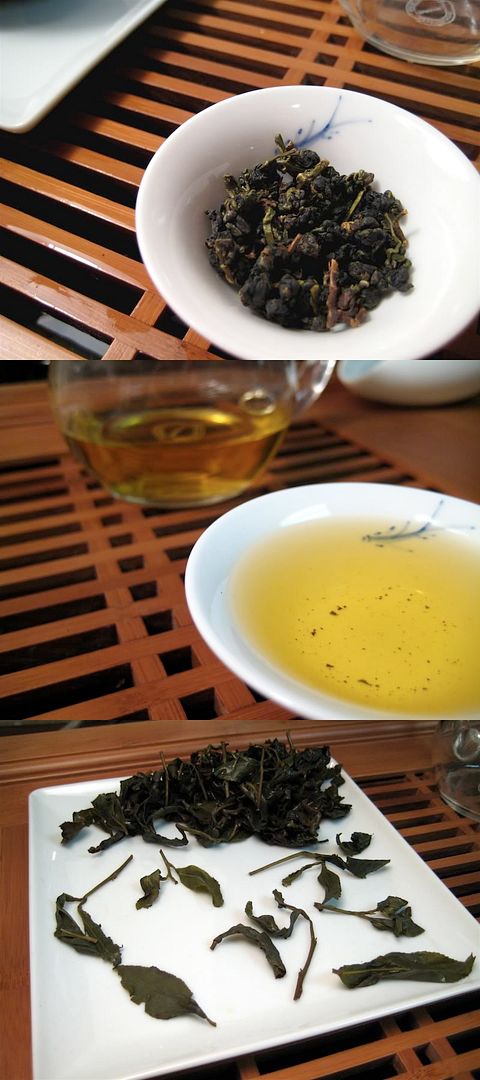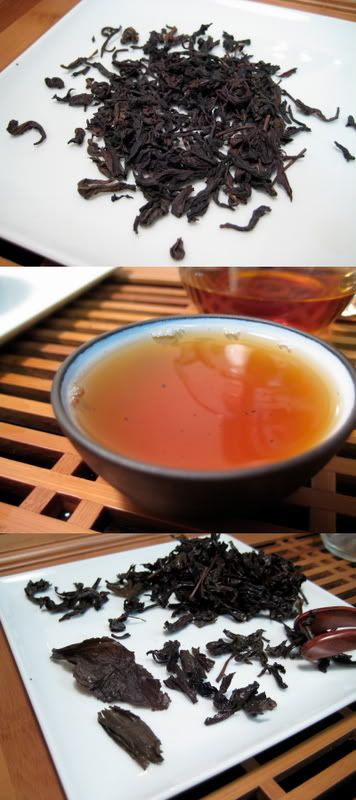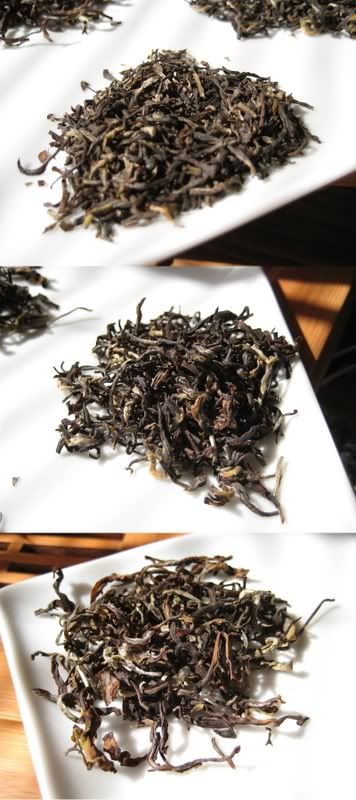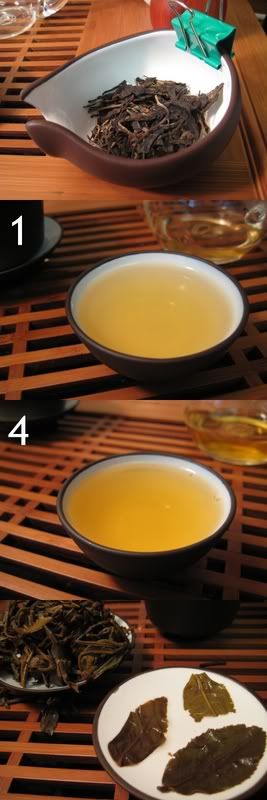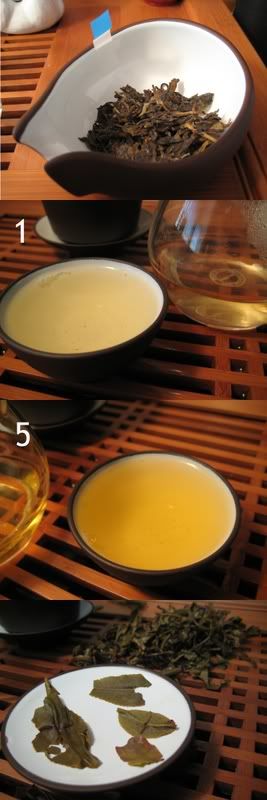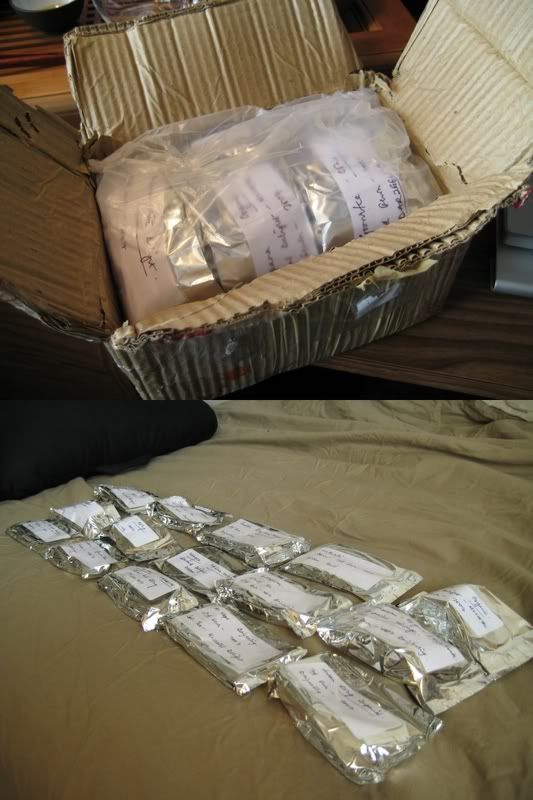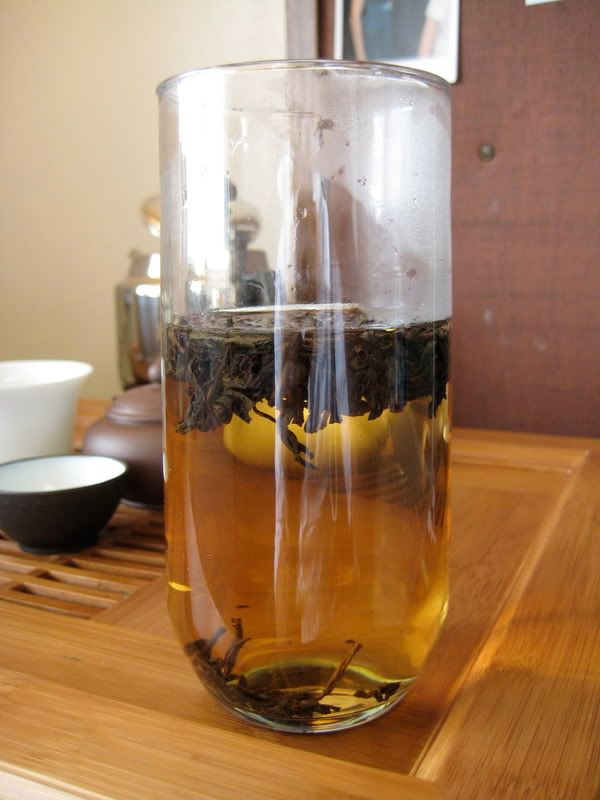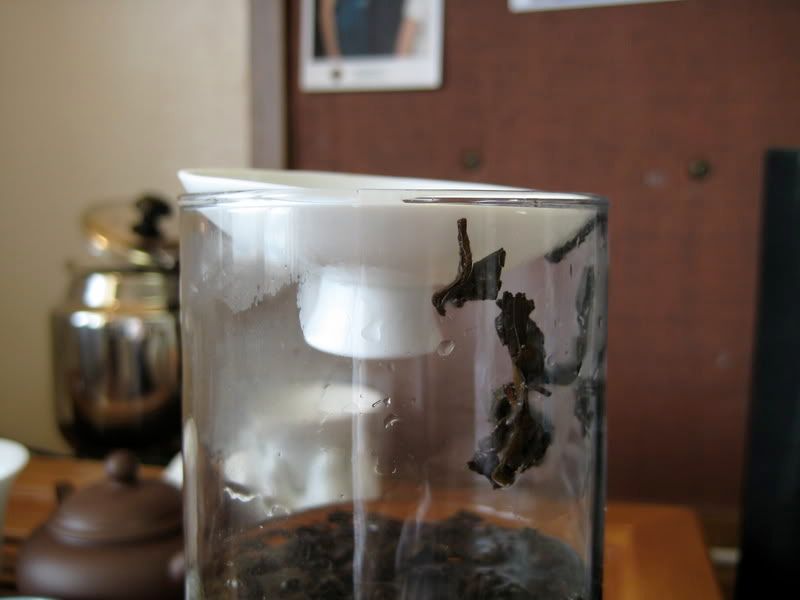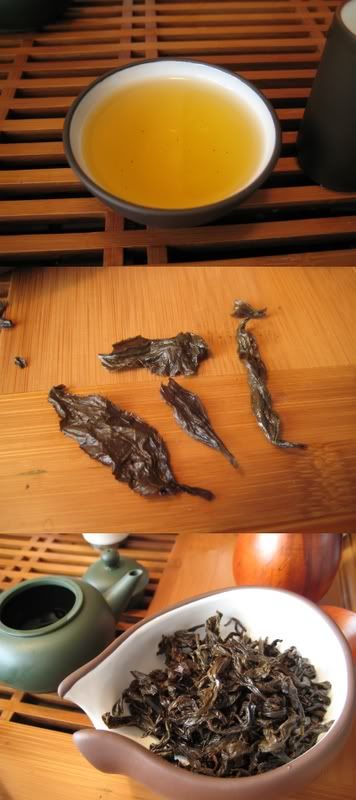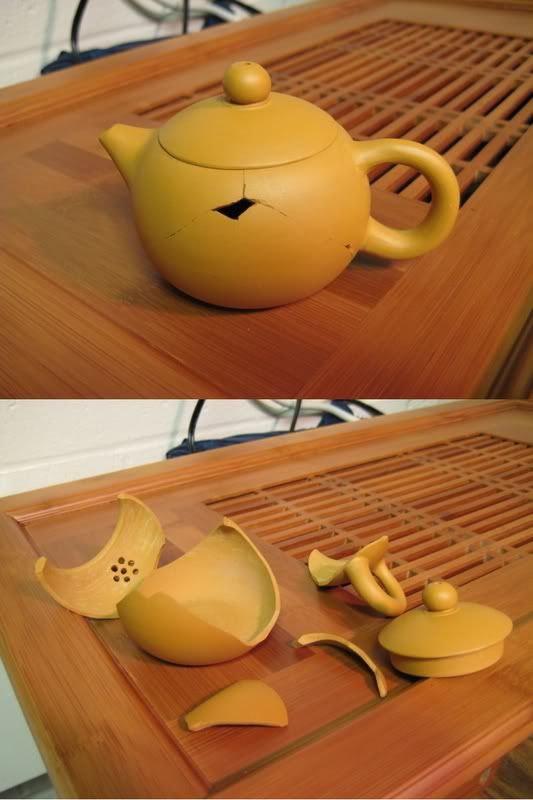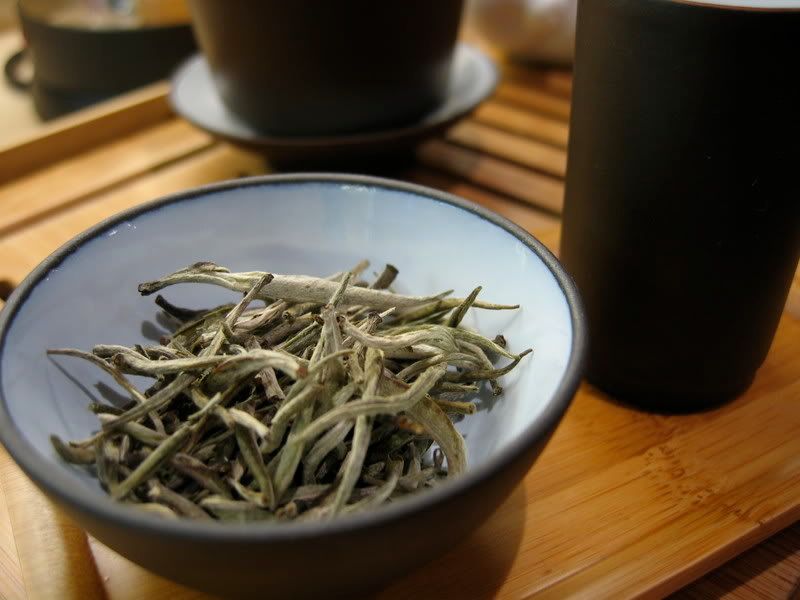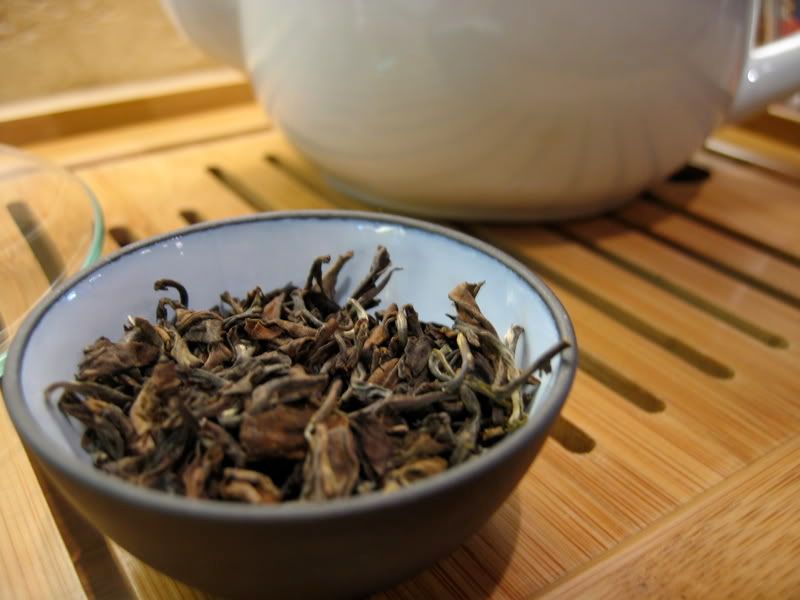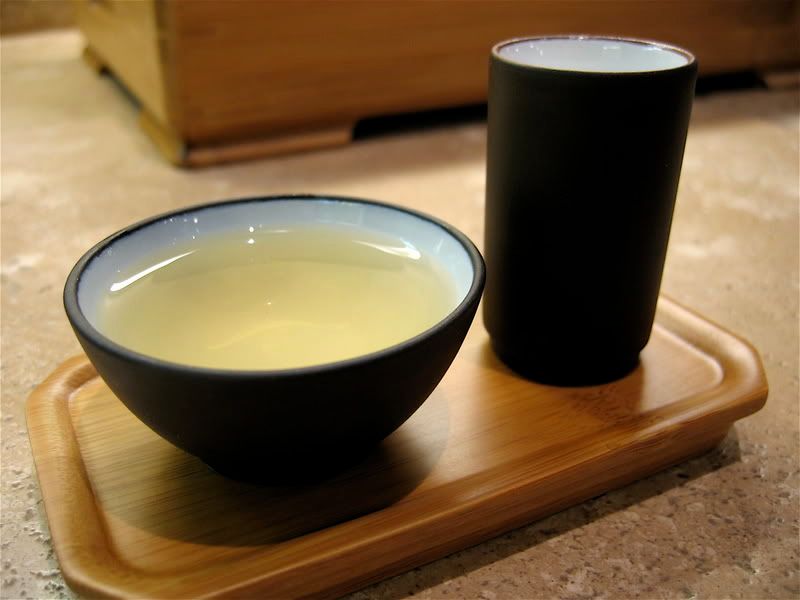Continuation of Matcha Madness: Part I and Part II.The Tools of the Trade:Preparing matcha with the traditional method requires quite a bit of specialized equipment, as you can see here.

From left to right we have a
chasen (whisk) held on a whisk holder, a
chashaku (tea scoop), a
chawan (tea bowl), a can of matcha, and a measuring cup. You don't technically
need everything shown here, but I would really suggest investing in this kind of setup. So, what do all these items do?
Whisk/Chasen: The
chasen has two purposes; it mixes matcha powder with water and incorporates air into the mixture (think of beating an egg white into a meringue), thus forming a homogenous suspension with a foamy froth on top. This is probably the single most important item in preparing matcha by traditional means.
These bamboo whisks are usually handmade by cutting a short section of bamboo lengthwise into many small tines. How many tines, you ask? The short answer is that it depends what kind of tea is being made. Don't worry though; as is the case with many aspects of matcha preparation, the number of tines on the whisk is important to performers of the tea ceremony and true matcha buffs, but likely makes no difference to the casual matcha drinker. So don't sweat it, and just buy whatever whisk feels right to you.
Whisk Holder: This is used to maintain the optimum shape of a bamboo whisk, which is easily warped by hot water. I've seen porcelain and wooden models, but I'm not convinced either is significantly better than the other. So, once again, it's up to you.
 Scoop/Chashaku
Scoop/Chashaku: The
chashaku is used to scoop and measure matcha. This is not an exact measure, but the picture shown here should give you a general idea how much one scoop's worth is equivalent to. The mass of one scoop's worth is approximately 0.75g, though this can vary from person to person or from tea to tea, depending on your technique or how densely packed your matcha powder is. Matcha scoops are almost always made from bamboo, and there isn't much variation in design unless you're getting really fancy.
Matcha Bowl/Chawan: The
chawan is the second most important item in traditional matcha preparation. It is much larger than a typical Japanese teacup, despite the fact that the typical serving of matcha is only around 4 fl oz (approx. 120mL). The larger size gives the whisk more space to move around and effectively mix the tea (more on this later). There are a number of
chawan forms and styles, but I am hardly an expert in Japanese pottery or art. I think the wide cylindrical shape (like mine, or
this one) is the easiest to work with, as it contains splatter much better than the flat, conical-shaped bowls (examples
here and
here).
Matcha bowls can be
very expensive, as you can see by the list prices on the linked examples above. These are mostly intended for Japanese art collectors and tea masters. However, there are many cheaper ones available on the internet for the rest of us. I particularly like the
selection at Artistic Nippon, but almost all Japanese tea vendors carry at least few of the more affordable models.
Measuring cup: Fairly obvious. This isn't really necessary once you get a feel for the ideal amount of water to use, but it's still useful if you want really consistent results.
Also needed but not pictured is a towel of some sort. I just use paper towels, but it doesn't really matter as long as it can be used to dry things.
How to Prepare Matcha the Semi-Traditional Way:First off, this is a purely functional method for preparing matcha. If you want to learn the Japanese tea ceremony, you will likely have to pay a good deal of money for the proper training. This is the next best way to enjoy matcha, and it's a lot cheaper!
Step 1: Setup and PreheatingFirst, set out all of your tools in a logical order so you don't have to fuss around or think too much. Bring your water to temperature (I like 170°F or so, but temperature doesn't matter nearly as much for matcha preparation as it does for steeping loose leaf tea), and fill your
chawan about 1/3 full. Rinse the business end of your whisk in the bowl, then discard the water and thoroughly dry the bowl with a towel. Both of these rinses prevent clumping later on, and rule #1 about matcha is that clumping = bad.
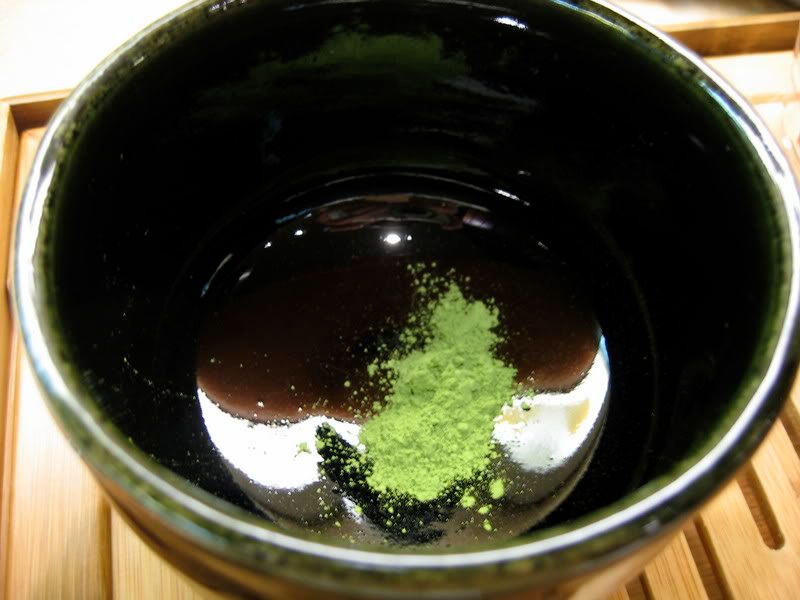 Step 2: Dry Team***
Step 2: Dry Team***For
usucha or thin matcha, add 1-2 scoopfuls of matcha powder to the warm, dry bowl. For
koicha or thick matcha, add 3-4 scoopfuls. You can swirl the powder around with the scoop if you like, but I don't think it helps much.
 Step 3: Wet Team***
Step 3: Wet Team***Add approximately 4 fluid ounces / 120mL of hot water (like I said before, temperature is up to you) to the bowl. Pour it somewhat slowly to keep the powder from flying.
 Step 4: Whisking
Step 4: WhiskingPut your recently rinsed whisk in the bowl and move it back and forth in an M or W pattern, occasionally giving the entire bowl a quarter-turn. Just like whisking when cooking, this requires a good deal of speed and elbow grease— wimpy whisking will almost definitely earn you a bowl of powdery tasting matcha. It takes about a minute of good, solid whisking to mix everything and work up a nice froth. Enjoy!

When you're done, you should end up with a nice frothy bowl of matcha. Drink it fairly quickly, because the matcha powder is not dissolved and will settle out of suspension if given enough time. Settling makes the tea taste powdery, which is bad. If this happens, whisk again or just swirl it around to re-suspend.
But wait, there's more!The observant among you may have noticed that I mentioned food grade matcha back in the second installment of this series. Why did I purchase so much food grade matcha, you ask?
Ice cream!
I'm not big on tea recipes, but matcha ice cream, more commonly and ambiguously known as "green tea ice cream," has always been one of my favorite desserts. So, I thought I'd share my recipe. Yes, you will need an ice cream maker.
Matcha Ice Cream Ingredients:
Ingredients:3 tbs food grade matcha powder
2 oz hot water
2 cups heavy cream
1 cup whole milk
1/4 teaspoon salt
6 egg yolks
3/4 cup sugar
Instructions:Add the cream, milk, and salt to a medium-sized saucepan. Heat until bubbles begin to appear around the edge of the saucepan (Do not bring this to a boil, or you will have a big mess on your hands).
Whisk together your matcha powder and hot water in a medium-sized work bowl. Just use a regular kitchen whisk (not a
chasen), and don't bother trying to whip up a froth; not only is it extremely difficult, but it is entirely unnecessary. This step is just to reduce any powdery consistency in the final product.
To the matcha and water mixture, add the sugar and egg yolks, and whisk to combine.
Temper the egg mixture by
SLOWLY adding the hot cream mixture, whisking constantly, until about half of the cream mixture has been added to the egg mixture. I can't stress enough that you must add the cream mixture slowly. If you do this too quickly you could literally scramble your eggs. This is bad.
Return everything to the saucepan. Cook the custard on low heat, stirring with a wooden spoon. Continue cooking until the custard coats the back of the spoon. If you've never done this before, this is how you know if it coats the back of the spoon: dip the spoon in the custard, and run your finger down it. If your finger leaves a mark with defined and stable edges, you're set.
Take the custard off the heat and pour through a strainer into a metal bowl. Cover with plastic wrap, placing the plastic directly on the surface of the custard to prevent it from forming a skin. Place this metal bowl inside a larger bowl filled with ice water. Chill in the water bath until the mixture is cold (this should take about one or two hours), adding ice to the ice bath as needed.
From this point, follow your ice cream maker's instructions. Put the soft ice cream into the freezer to harden for at least 2-3 hours, and devour.
Conclusion:Well, that was certainly a lot about matcha. All of this information can be found somewhere on the internet, but I haven't yet seen it all in one place. I hope this serves to educate and interest you loyal readers in the casual enjoyment of matcha, because I'm not writing anything more about it for a long time. :)
Anyway, I hope you enjoyed this three-part series. I have a couple new and somewhat oddball articles in the works, so as always, stay tuned!
***If you get the reference, you're awesome.
 Class: Oolong
Class: Oolong It seems to be chance when it *really* works– it often helps a little bit, but occasionally something dramatic happens. With this tea, one of the times I tried this I got a sudden and specific "ORCHID!" taste, but the other attempts were nothing that special, but still nice. Anyway, I hope some of you find this fun/helpful/interesting.
It seems to be chance when it *really* works– it often helps a little bit, but occasionally something dramatic happens. With this tea, one of the times I tried this I got a sudden and specific "ORCHID!" taste, but the other attempts were nothing that special, but still nice. Anyway, I hope some of you find this fun/helpful/interesting.
